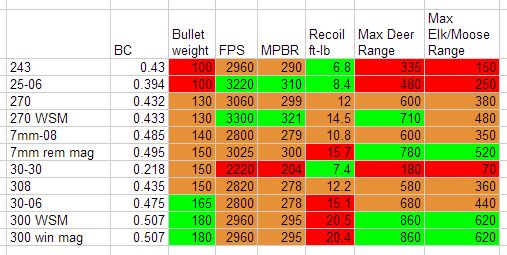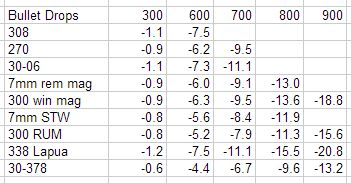Yeah, yeah, I know they’re cartridges and not calibers, but lots of people call them calibers so I thought I’d roll with it. I thought I’d run an article on the flattest shooting rifle cartridges to compare and contrast both what’s popular, as well as a few of the high performance options out there.
The Flattest Shooting Common Hunting Cartridges
I’m going to set a restrictive definition on “common” and only include cartridges that can be found chambered in most any rifle. No exotics just yet, they’ll come later. I’d consider a base of:
- 300 win mag
- 7mm rem mag
- 30-06
- 270
- 25-06
- 308
- 243
Among these cartridges, the 25-06 offers the highest MPBR (Mean Point Blank Range) or the max distance that you can adjust a scope to and be +-3″ with the most common bullet weights per caliber. However, the lead that the 25-06 has is pretty small. Here’s a chart from my Popular Hunting Cartridges Compared article. Take a look at the MPBR column and note how close they all are.

So if you take “flat shooting” to mean aiming right at something far away and hitting it, there’s not really enough difference between the main popular cartridges to get out of bed for. Unless you’re shooting really far.
Common Hunting Cartridges at 600 yards and beyond
So what if we shoot further than 300? Most shots are taken at short range, but some experienced marksmen with good rifles, known distances, and good conditions may need to make connections at longer distances. At 600 yards, most common cartridges are running out of juice to take down larger game like Elk or Moose, though the 300 win mag/300 WSM still have a bit left in the tank. 243 and 25-06 had to be left out because it didn’t have enough at 600 for even deer. How about our drops on the cartridges that made it? To even things out, I’ve zero’d all cartridges at 100, drops are listed in feet and cartridges that fell below 1000 ft-lbs didn’t get past the next 100 yard clip.

So, if you want to go long, there are some clear choices here. 270 and 30-06 carry enough power out to 700 yards, 7mm pulls a bit further, and 300 win mag pulls a bit further still. Not a lot of difference in drops between the cartridges though; you need accurate yardage readings to get your drop correct.
There’s Extreme Hunting Cartridges
I’m going to include a few in here, and my basis for including them is going to be inclusion in Federal’s 2013 catalog, because that’s what I’m basing my numbers off. These are all under my “extreme” heading, because they’re all brutal on cost and recoil.
- 7mm STW with a 160 grain bullet
- 300 RUM running a 180 grain bullet
- 338 Lapua with a 300 grain projectile (you can run 250’s in the Lapua as well, but most run a 300)
And then there’s the Weatherby 30-378
While heavier bullets at low speed don’t shoot as flat, they do carry energy further generally. Now, one manufacturer specializes in fast, powerful, ridiculous cartridges, and that’s Weatherby. They have 1 particular cartridge that’s something of a hot-shot for flat shooting, long distance devastation; the Weatherby .30-378. I had to calculate this one out, as Weatherby’s ballistics charts don’t go past 500 yards. I ran the numbers with the 180 grain Ballistic tip at 3420 fps. (not the bullet I’d choose for this beast, just puts it nicely in line with the others)
What does that do for you at regular ranges? It gives you an MPBR of 336 yards. That’s comparing apples to apples with the others up above, using a 6″ vitals zone. Kind of underwhelming, right? I mean, it’s the flattest shooting cartridge around, but you took a huge bump in recoil over the 300 win mag or even 270 WSM for 41 more usable yards of MPBR. To be fair to the 30-378, it murders everything else for flatness way out there, staying feet above most other cartridges and carrying enough energy to take a deer at just over 1000 yards. It just murders your shoulder, ears, and pocketbook at the same time 😉

Shooting at 700 (In Theory)
Although it’s going to be easier to estimate drop for a 700 yard shot with a 30-378, compared to a 30-06, you still need to range your animal within +/-25 yards using the 30-378 to hit vitals. A 100 yard miscalculation short or long will vary your hit by a vertical of 2.3-2.9 feet, enough to completely miss or wound the deer. A 25 yard miscalculation at that distance will vary your hit by half a foot and outside our 6″ imaginary circle of vitals. With the 30-06, we can only overcome 12 yards of ranging error at the same range before we miss the 6″ of vitals. So it’s not like the flattest shooting rifle gives you a lot more leeway on ranging errors for super long range shots. You still need excellent range finding equipment and preferably have tested drops in your rifle in case your bullets have exaggerated BC claims. Our margin for distancing error at 700 yards just went from 12 yards with the 30-06 to 25 yards with the 30-378. If you don’t have good range finding equipment, you’re hooped either way; humans will have extreme difficulty judging 700 from 725 without physical land markers or other range finding signs.
So what can we learn from these numbers? Well, nothing will save you if you mistakenly range a deer at 700 yards that’s really at 800. You’re going to miss with any flat shooting cartridge out there and with a perfectly accurate rifle. And while that pokey 300 grain 338 Lapua round drops quite a bit compared to the others in the list, it’s carrying a lot of energy: enough to take a deer at 1775 yards. My take away on all this number crunching? Most common calibers are just fine for regular range shots under 300 yards. Accuracy, knowledge of your rifle and its drops at different ranges, and knowledge of the conditions will dictate your very long range shots.
Want to run your own ballistics numbers? Check out ShootersCalculator.com